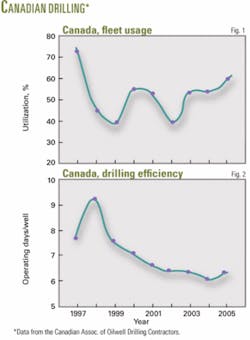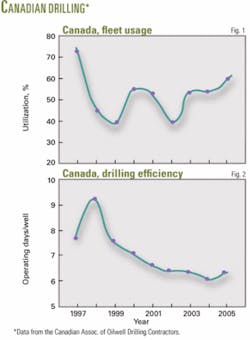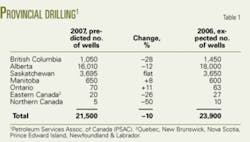The drilling industry appears to be on the upside of a supercycle, keeping most rigs busy in North America.
Both oil and gas prices have stopped their rapid upward climb, but rigs are still working. The total number of US oil rigs is up slightly but relatively flat over the last 5 years. The bigger story is in the number of rigs drilling for gas in the US, which has doubled in only the last 3 years.
December contracts on the New York market for US crude oil benchmarks expired Nov. 17 at the lowest closing price in 17 months (OGJ Online, Nov. 20, 2006). In some areas, reduced natural gas prices have caused operators to scale back development drilling. Yet operators are proceeding with major exploration projects and leaving few rigs idle, on or offshore.
Day rates in the Gulf of Mexico are depressed only relative to other international markets; rig profitability in the gulf has increased 223% over the last 5 years. Yet the local day rates have caused a steady flow of rigs out of the gulf, while overall worldwide utilization has remained high.
Land rigs in North America are susceptible to fluctuations in gas price, yet rig construction and refurbishment continues at a rapid pace, with most new rigs anchored by term contracts.
Modest softening in gas drilling has caused some companies to shift assets to oil-oriented regions such as the Permian basin and California’s San Joaquin basin.
Outlook
Marshall Adkins, managing director of Raymond James & Assoc. expects the global drilling market to be “pretty healthy” for the next 5 years,” and said that the US land fleet will continue to grow at 10-12% (net) for “at least the next year, and probably the next 3 years.”1
Richard Mason uses three indicators (drilling permits, trailing 6-month oil prices, trailing 12-month gas prices) to forecast US drilling activity 60, 180, and 270 days out, for The Land Rig Newsletter’s “drilling activity oscillator.” He was unusually pessimistic in October, publishing the most negative report yet. Based on his indicators, he forecast reduced drilling over the next 2, 6, and 9 months.
The last few times Mason came close to issuing such a negative prognosis were in July 2003 and July 2002, when he forecast 60-day drilling outlook down and 180-day and 270-day outlooks flat.
In the October 2006 issue, however, Mason reasoned that some of the indicators might be unreliable, and said the latest forecast might be a “false negative.”
“The industry can’t survive $4[/Mcf] gas, though it doesn’t need $12 either...why fret with gas in the $7s?”
US drilling
Baker Hughes Inc. reported 1,717 rotary rigs working in the US the week of Dec. 1, 2006, up 18% (257 rigs) from a year earlier. This includes 1,608 land rigs (up 18% from a year ago), 86 offshore rigs (up 10% from a year ago), and 23 rigs working in inland waters.
Regionally, Texas led the states with 771 rigs drilling, followed by Louisiana with 193 rigs, and Oklahoma with 183 rigs. Drilling is also strong in the Rocky Mountain area, with 87 “oil-directed” rigs drilling in Colorado and 90 rigs drilling in Wyoming.
Most of the rigs working in the US were drilling vertical holes (1,028 rigs; 60%), while 374 rigs were drilling directionally (22%), and 315 rigs were drilling horizontally (18%).
Most rigs (1,423; 83%) were drilling for gas, up 19% from a year ago. Another 289 rigs were drilling for oil, up 9% from a year ago.
The Land Rig Newsletter composite rig count tracks the fleets of the five largest drilling contractors (Nabors Drilling US LP, Patterson-UTI Energy Inc., Grey Wolf Inc., Unit Drilling Co., and Helmerich & Payne Inc.) and accounts for nearly half of the US rig fleet.
The composite counts all rigs working under contract, including those mobilized, not just rigs turning to the right. The composite count showed 761 active rigs on Nov. 10, down 37 rigs from Oct. 27. Patterson-UTI had 20 fewer rigs; Unit was down 11; Nabors and Grey Wolf each lost 4 rigs. Only H&P added rigs (2) for the week.
H&P
In November, Oklahoma’s Helmerich & Payne Inc. announced results of its fiscal year, ended Sept. 30. Hans Helmerich , president and CEO, said the company’s “earnings for the current year more than doubled our previous all-time high of 1 year ago.”
H&P has been buying back its stock; about 2 million shares since July 2006.
The company owns 117 US land rigs, 11 US platform rigs, and 27 international rigs.
For the US land rigs, H&P reported average revenue/day of $24,343/rig ($13,288/day net) for this fiscal year’s fourth quarter, compared with $23,503/day ($12,938/day net) for the previous quarter.
H&P’s US land rig utilization averaged 99% in fourth (fiscal) quarter, up from 95% a year earlier.
Since March 2005, the H&P has announced plans to build 73 new FlexRigs, all with minimum work commitments of 3 years. By the end of 2007, all will be completed; 28 have been finished to date.
Barnett shale
One of the largest gas resource plays and largest growth areas in the US, the Barnett shale has attracted drilling by Devon Energy Corp., XTO Energy Inc., EnCana Oil & Gas, Chesapeake Energy Corp., EOG Resources Inc., Denbury Resources Inc., Quicksilver Resources Inc., Southern California Public Power Authority, Royal Dutch Shell, and DTE Gas Resources, a subsidiary of DTE Energy Co., among others.
The Barnett play is attracting tremendous growth. So far this year, 2,322 drilling permits have been issued for wells in the Barnett, a 16% increase over the 2,006 permits issued in 2005, and 67% increase over the 1,387 permits issued in 2004.
There are about 165 active rigs, and about 200 are likely to be working the play in 2007.3 The wells are predominantly (80%) horizontal, enhanced with slickwater fracs (OGJ, Mar. 7, 2005, p. 41).
Houston-based newcomer, Mountain Drilling, is also providing new, Italian-built Drillmec HH300 hydraulic rigs to the Barnett market.
In late October, however, Calgary’s EnCana announced plans to cut 4 of its 12 Barnett shale drilling rigs, due to “rising expenses,” saying that rigs now cost $20,000-22,000/day. The company had previously announced plans to drill at least 100 wells in the Barnett in 2007, primarily in Denton and Tarrant counties, Texas. The company also plans to cut rigs in Colorado and Wyoming.
Mason observed in his recent newsletter that operators are “pushing hard for rollbacks in rig rates, typically by threatening to let rigs go.” But he also noted that a lot of E&P firms are still looking for rigs, and to give one up voluntarily means risking delay in getting a replacement. “Demand for drilling services has risen in tandem with commodity prices.”1
Gulf of Mexico
The offshore fleet working in the Gulf of Mexico is about 112 rigs: 70 jack ups, 29 semisubmersibles, and 6 drillships. Overall utilization at the end of November was about 80%, according to ODS-Petrodata Group. Although the drillships were 100% engaged and the semisubs 94.5%, only 73% of the jack ups were working.
The Rowan Paris jack up is the latest rig to leave the gulf, after finishing a $160,000/day contract. It will spend 3½ months in a Qatar shipyard before starting a 2-year contract with Maersk Oil at $190,000/day.
GlobalSantaFe Corp.’s monthly summary of current offshore rig economics (SCORE) was about 111 for the Gulf of Mexico in October, down nearly 6% from the previous month but up 16% from a year earlier and up 223% from 5 years earlier.
Regionally, the gulf has the lowest SCORE for any of the regions tracked worldwide, suggesting that prices are locally depressed for jack ups and floaters. This is borne out by a continuing exodus of rigs from the gulf into other areas.
Service rigs
The Weatherford-AESC well-service rig count increased to 2,440 rigs for October 2006, up 2.5% (60 rigs) from the previous month and up 5% from a year earlier. Rig utilization was at 74%. Weatherford took over the count from Halliburton in July 2001.
Houston’s Key Energy Services Inc. (www.keyenergy.com) provides well services, pressure-pumping, fishing, and rental services worldwide, with more than 7,500 employees. CEO Dick Alario reported at the Bank of America Energy Conference on Nov. 16 that revenue in its second fiscal-year quarter (ending Sept. 30, 2006) had beaten the forecasts. The company attributed the positive result to higher pricing, expanded capacity, and increased rig hours due to additional working days. Key Energy had 677,271 well-service rig-hr, up 2% from the previous quarter and a corresponding profit margin expansion to 43% from 39%.
The company is moving some assets out of the San Juan basin and Midcontinent areas and plans to set “new pricing initiatives” across all regions in first-quarter 2007.
Canada, 2006
Baker Hughes reported 442 rigs drilling (turning to the right) in Canada during the week of Dec. 1, down 32%, or 211 rigs, from a year earlier (653 rigs). Land drilling dominates with 438 rigs, with only 4 rigs working offshore (3 off Newfoundland, 1 off Ontario). Alberta led land drilling with 319 rigs, followed by Saskatchewan (67 rigs), and British Columbia (49 rigs). Manitoba had two and Newfoundland had one land rig working.
The rig count reached a record high of 715 during the last high season (February 2006), but gas well drilling has dropped precipitously since last winter. Still, most (301) rigs were drilling for gas during the week of Dec. 1 (68%), compared with only 141 rigs drilling for oil.
The Canadian Assoc. of Oilwell Drilling Contractors reported 495 rigs working under contract in Western Canada for the week ending Dec. 5, with 347 rigs down, a 59% utilization rate.
Historically, CAODC reported 749 rigs working, on average, in 2005, at about 60% utilization (Fig. 1).
Drilling efficiency has increased in the last decade in Canada, according to data from the CAODC. Wells now require an average of 6.3 days to drill, down from a high of 9.3 in 1998 (Fig. 2).
From Ottawa on Oct. 31, Canada’s Harper government announced plans to end the tax-free status of trusts in 2011, raising the possibility that the E&P industry would be affected by the flight of capital from energy trusts. Dow Jones reported on Nov. 2 that six of top 10 funds on the Toronto Stock Exchange were Calgary-based oil and gas trusts and all had dropped in value.3
“It’s going to be harder for larger companies to take their mature properties and sell those to energy trusts, then take the cash for that and go do exploration,” said Bill Schulz, at Calgary’s Haskayne School of Business.3
In response to the government’s action, 40 different energy trusts formed the Coalition of Energy Trusts, which claims that the sector plays a “vital role in developing lower production fields that are avoided by larger oil and gas companies.” The Coalition said the energy trusts have invested $10 billion (Can.) into the oil patch in the last 5 years and are responsible for 20% of Canada’s crude oil and natural gas production.4
Canada, 2007
On Nov. 1, the Petroleum Services Association of Canada issued its 2007 Canadian drilling activity forecast, predicting “the first slowdown in petroleum industry field activity since 2002” (www.psac.ca).
PSAC expects 21,500 wells to be drilled across Canada in 2007, about 10% fewer than the final tally expected for 2006-23,900 wells (Table 1). The expected well count for 2006 is about 5% lower than the number predicted by PSAC in October, largely due to reduced gas drilling in Alberta.
In 2007, PSAC expects industry to drill about 1,300 more oil wells than in 2006. Estimates are based on $60/bbl (US, WTI) and $6.25/Mcf (Can.).
East Canada
Expect more drilling off Eastern Canada over the next few years. Companies bid $32.4 million (Can.) for licenses off Newfoundland in the 2006 land sale on Nov. 16, under Call for Bids NL06-1 and Call for Bids NL06-3, according to the Canada-Newfoundland and Labrador Offshore Petroleum Board (C-NLOPB; www.cnlopb.nl.ca).
Most of the bidding ($31.4 million Can.) was for commitments to drill in the Jeanne d’Arc basin, followed by $956,008 (Can.) committed to drill off western Newfoundland.
Calgary’s Husky Energy Corp. bid $15.5 million (Can.) on their own, as Husky Oil Operations Ltd., for 24,800 hectares near the southern border of the Terra Nova oilfield. Norsk Hydro Canada Oil & Gas Inc. joined Husky as equal partner in $5.5 million and $10.4 million bids for two parcels lying south of the White Rose field.
Husky announced on Nov. 20 that it would drill two more wells off Newfoundland at North Ben Nevis and Fortune in the Jeanne d’Arc basin. Husky’s partners at North Ben Nevis are ExxonMobil, Petro-Canada, Norsk Hydro, and Chevron. Partners at Fortune include Petro-Canada, Norsk Hydro, and Chevron.
In West Newfoundland, NWest Energy Inc. bid $550,008 on two parcels off the Northern peninsula and B.G. Capital Ltd. bid $406,000 on a license for a tract off the Port au Port peninsula.
The 9-year exploration licenses will be issued by C-NLOPB in January 2007. Under a new licensing scheme, parties have 5 years in which to drill with the money committed and then will be assessed rental fees of $20/hectacre (Can.) for any “major finds left fallow.”
Mexico
Baker Hughes reported that 82 rigs were drilling in Mexico in October 2006, including 58 land rigs and 24 offshore rigs. This is 11% fewer rigs than a year earlier, when 92 rigs (62 land; 30 offshore) were drilling in Mexico. Most (48) of the rigs were drilling for oil in October 2006; 31 were drilling for gas, and 3 others were listed as having “miscellaneous” objectives.
References
- “Wall Street Outlook: Drilling business looks healthy for the next 5 years,” Drilling Contractor, Nov.-Dec. 2006, p. 26.
- “Barnett Boom Continues; Where are the super-majors?” Intelligence Press, Nov. 17, 2006.
- “Energy-Trust Losses Could Affect Canada Oil Exploration,” Dow Jones, Nov. 2, 2006.
- Monchuk, Judy, “Prentice says oilpatch anger over trust taxes is waning, critics disagree,” The Canadian Press, Nov. 17, 2006, www.cp.org.



